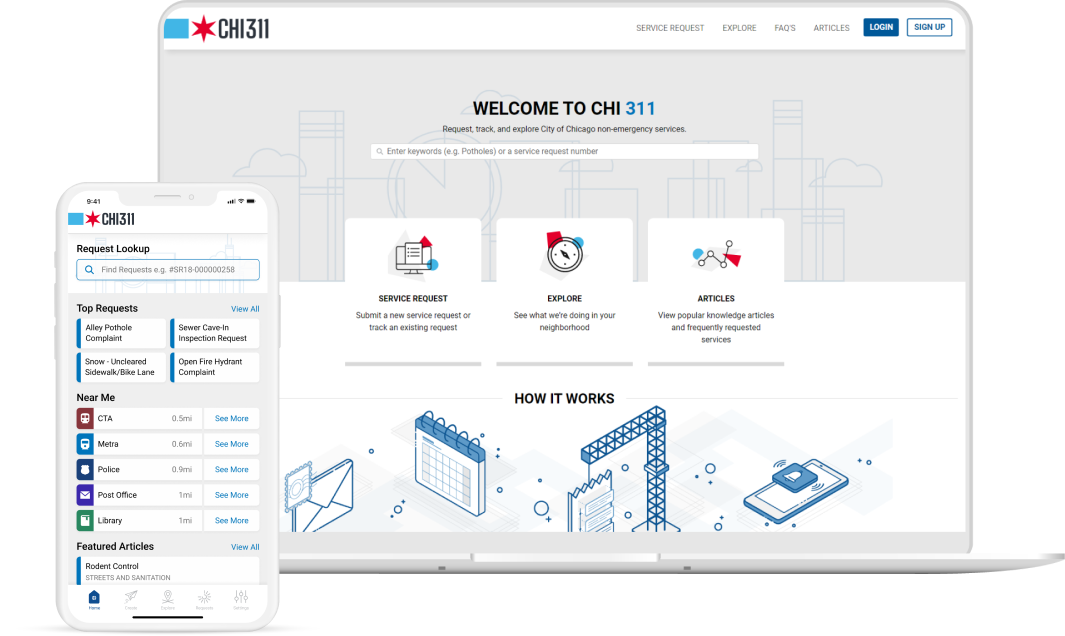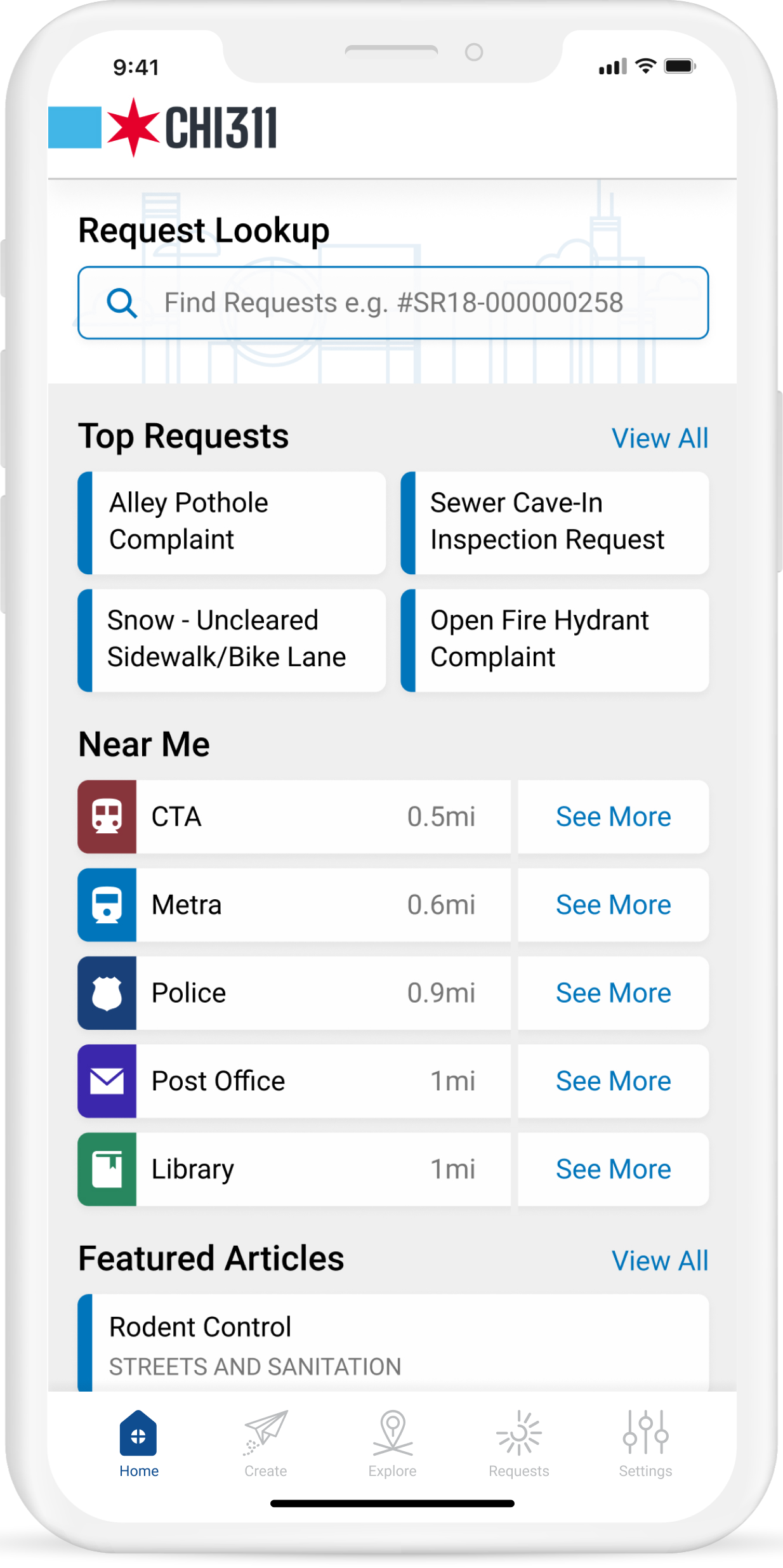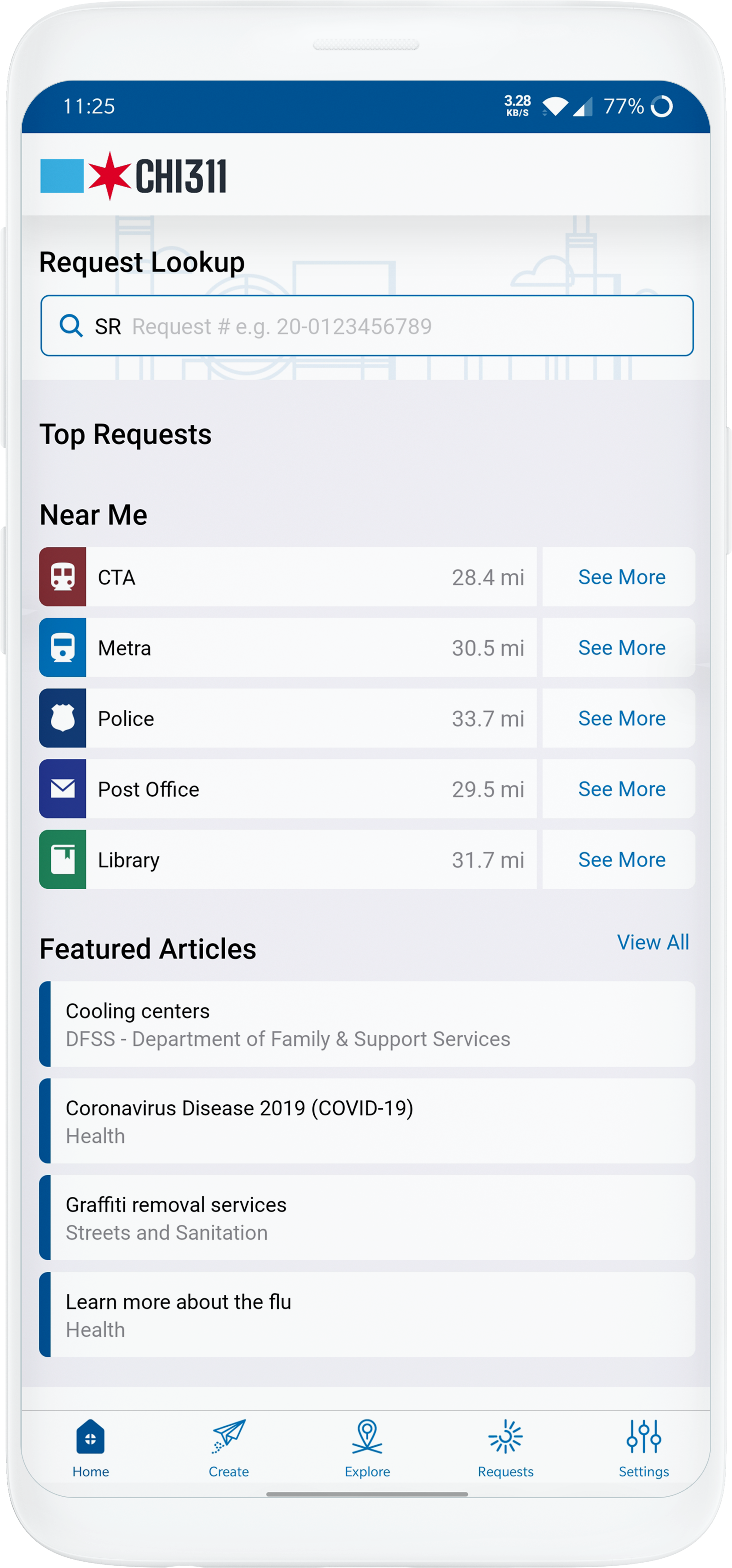Catalyst is a 4-Time Salesforce Partner Innovation Award Winner. Learn More.
Building Chicago's
311 System
Client
- The City of Chicago
Project Focus
- Design
- Salesforce
- Strategy
Awards
- 2019 Salesforce PIA
- Walk Me
- Design & Innovation Award
Nearly three million people call the City of Chicago home. In the City with one of the biggest non-emergency 311 systems nationwide, a constituency of this size equates to thousands of calls coming into Chicago’s 311 call center daily. So when the system was nearing its 20th year in operation, virtually unchanged since its launch in 1999, the City knew it was ready for an upgrade. In close collaboration with Chicago’s Department of Innovation and Technology (DoIT) and 311, Catalyst leveraged Salesforce’s Government Cloud to modernize the City’s 311 system by bringing it onto the cloud, increase interdepartmental collaboration, and improve the City’s communication with its residents.
Before updating to Salesforce, Chicago’s 311 consisted of a Motorola-based CRM, a public-facing service request intake form, and a mobile text-to-case feature that supported 13 service requests. Moving the 311 call center and the 33 City departments it supports over to the new system resulted in one of the largest 311 modernization projects in North America to-date. The new system consists of a cloud-based CRM, field service management, a digital knowledge base, an intuitive Community Portal, and the City’s first-ever citizen facing mobile application.

Modern Case Management with New Features to Take Advantage of.
The City’s new 311 system improves existing functionality, but also adds a number of new features that City departments, 311 operators, and City residents can take advantage of. At the core of this system, though, is modern case management. While 70% of the calls 311 receives are informational, about 30% are infrastructure-related and require the attention of City departments.
Chicago’s new CHI311 utilizes Salesforce’s Service Cloud to create a case from multiple channels: 311 operators via the call center, City departments in the field, and residents using the new Community Portal and mobile app. From there, automated case routing sends the case to the appropriate department to be worked via guided flows for admins in the office and Salesforce’s Field Service Lightning for the department workers in the field. Digitizing the City’s work order management alone has saved the City time and money.
City Engagement
from Start to Finish.
Catalyst was devoted to keeping engaged with City departments throughout the entire Business Process Re-engineering process to ensure City acceptance and sign-off.
Scheduling a Request
Scheduling a grafitti clean-up request used to take up to 60 mins. The new CHI311 has reduced that time to 10 mins.
Case Closure
Overall case closure rate has increased from 82% to 94%.
A Public Facing Community Portal with a Plethora of New Features.
Prior to launch, the easiest way for residents to submit a service request was by calling 3-1-1. The City had a web-based intake form, but it was neither user-friendly nor intuitive. Furthermore, the only way residents could track the progress of their service request was also by calling 3-1-1 for updates. To help the City achieve its goal of providing an Amazon-like experience for residents, we leveraged Salesforce’s Community Cloud to develop a best-in-class public-facing website, CHI311.
The biggest gain from the new CHI311 Community Portal is the ability to track a service request from submission to completion completely online. Through the Portal’s “Check Status” feature, users can now check the status of their request at any point, understand the estimated days expected to complete their request, and see real-time updates from City departments regarding the progress of their work.
Site Analysis
Completed in-depth site analysis of existing 311 websites with City stakeholders to develop requirements
Increased Service Requests
Increased service requests available online from 88 to 120 and growing to maximize resident self-service
Leveraging Feedback
Leveraged feedback from resident focus groups to update service request names, descriptions, and categories to increase user acceptance
Lightning Component Integration
Utilized Salesforce’s lightning components to hook the backend CRM system to the public-facing Portal for system synergy
Giving CHI311 an Updated Design that is Both Modern and Functional.
While working with the City of Chicago, Catalyst developed wireframes, sketches, and eventual mockups of full-functionality and Portal design. We also ensured that the new CHI311 had an improved User Experience and overall more modern design that was kept in line with the City of Chicago’s brand guidelines.
Improved UX
The existing CHI311 Community Portal was outdated and cumbersome to use. The Catalyst Team worked with the City of Chicago to improve the user interface and overall user experience of the new CHI311 by taking the service requests out of their existing drop-down list and into nine categories and sub-categories for an improved user experience.
Knowledge Base
Provides an outlet for the City’s new digital library, Knowledge Base, to support resident self-service and decrease the number of calls to 311.
User Feedback
Provides users with an outlet to send feedback and reviews on the Portal for ongoing improvements.
A Custom Mobile Application for the Modern Age.
Much like the Community Portal, the City’s first-ever citizen facing mobile application takes the burden off 311 operators and provides an outlet for resident self-service. The CHI311 mobile application is integrated with the backend Salesforce CRM solution to allow residents to submit service requests, check the status of their request, and search for other requests in their neighborhood.
Additionally, the CHI311 mobile app provides users with personalized City information based on their location such as ward and alderman. Geospatial information through the “Near Me” functionality acts as a guide for locating important City locations such as the nearest CTA station, post office, police station, library, and more. This makes the CHI311 mobile app more than just a way to request and track services; it’s a way to get around. Chicago is a City of 2.8 million people, 77 community areas, 140 bus routes, 8 subway lines, 80 public libraries, and 69 post offices, all of which are encompassed in this one app.
Bringing the Mobile Lifestyle to Chicagoans.
Catalyst developed Chicago’s first-ever resident mobile app available on iOS and Android.


Auto Suggestions
Provides type-ahead auto suggestions and the ability to enter intersections instead of exact addresses.
Push Notifications
Provides up-to-the minute push notifications regarding service request progress, when opted-in.
User Accounts
Allows users to remain anonymous or create an account for additional features.
Service Request Keywords
Developed service request keywords to help users easily locate their desired request resulting in a more intuitive user interface.
App Feedback
Provides users with an outlet to send feedback and reviews on the mobile appfor ongoing improvements.
A Fully Digital Knowledge Base That’s Always a Few Clicks Away.
Nearly 70% of Chicago’s 311 call center intake is informational, so it was important to provide residents with a digital library allowing them to self-serve, but to also modernize the way 311 operators shared and managed helpful City information. The legacy system provided no outlet for operators to digitally access and share relevant, updated information such as department news, flyers, hours of operation, or contact numbers. Prior to launching CHI311, operators maintained a series of paper-based binders that housed years’ worth of departmental assets. The binders were difficult to maintain and often times out of date.
By leveraging Salesforce’s Knowledge our team was able to transform 311’s paper-based binders to a fully-digital library that is easily accessible and maintainable. Our team worked with every department to update existing articles and create new ones when needed. Through the new knowledge base, departments take ownership of the information they share with 311, removing the burden from 311 operators. Departments can choose whether to share a knowledge article on the Community Portal and mobile app or not, opening the digital library up to residents to self-serve when possible and improving the flow of information.
Update Articles
Worked with each department to identify a content author and update relevant articles
Paper to Digital
Converted the 311 operators’ paper-based binders from ~ 1,000 pages to ~ 600 relevant digital assets
Self Service
Allows residents to self-serve, decreasing the number of calls to 3-1-1
Ownership of Content
Allows departments to take ownership of their information and content
Collaboration & Communication Across All Departments.
With 33 distinct departments each encompassing additional bureaus and divisions, departmental collaboration and communication is of the highest importance to the City of Chicago. In the legacy system, departments were siloed and rarely worked together to resolve resident service requests. Even when a request would transfer from department to department, the legacy system did not fully support the transfer of information often necessary to properly carry out the work.
Prior to CHI311, there was no distinction between a service request and a work order. Our team worked with the Department of Innovation and Technology, 311, and City departments to separate service requests (cases) and work orders (departmental work). In the new system when a resident makes a request, both a service request and a work order are created. With this new approach, all department work is handled through work orders which all roll-up under the resident’s service request. This allows departments to carry-out their work but to create multiple work orders under the same service request and communicate easily across work orders. This provides residents with a full-view of the work required to complete their request and keeps them in a constant flow of communication with the City. Most importantly, our team consolidated the activities departments use to describe their work and updated the language to terms residents would understand.
Activity Consolidation
Consolidated department work order activities from 500 to 80
Transfer Requests
Allows departments to transfer service requests and view relevant and important information to complete the work
Work Order Split
Service request-work order split provides users the full lifecycle of a request, even when transferred between departments
Salesforce Chatter
Salesforce’s Chatter feature provides departments an outlet to communicate and collaborate on service requests when necessary
Integrating One of the Largest 311 Systems in the Nation.
Since Chicago’s 311 system is one of the largest in the nation, taking in requests for everything from graffiti complaints to senior well-being checks, the system interacts with nearly every City department. CHI311 sits at the center of a web of over 15 inter-related and non-related systems used by each department. It’s the system integrations that allow departments and City vendors to receive a work order, complete the work, and close out the request without having to log into a separate system.
Our team worked with stakeholders from each City department to ensure the flow of data and information between their system data and the new CHI311 was seamless. In the process we standardized work flows, identified unique integration points, and assisted in making edits to both systems when necessary.
System Integration
Integrated with 15+ external systems and applications with the goal of adding more as the system advances
Developing APIs
Developed two main APIs that all systems must call: Create Service Request and Update Service Request
Established Center of Excellence
Established a center of excellence to align on any change requests to the API REST end points
Enhanced Reporting with All-New Metrics to Maximize Department Efficiency.
The legacy system housed thousands of reports used by 311 and City departments. To ensure we did not remove functionality from departments on the new system, our team recreated essential City reports using Salesforce’s reporting capabilities within Service Cloud, but also through Salesforce’s Einstein Analytics. This allows users to access the same data points they had in the old system, but to also create and run their own reports using the additional data in the new system.
Since all data within Salesforce is reportable, our team further improved the department experience by creating unique dashboards that provide key performance metrics upon login that are customizable by department or individual user such as number of work orders completed/open, resource performance, cases by source, and more.
Dashboard Metrics
Examples of dashboard metrics by reporting include cases created yesterday, current escalated cases, cases opened by shift. Duplication criteria can include service request, distance, age, status, and more
Providing Department Insight
Provide departments the insight they need to adjust resources and maximize work efficiency
Modernizing Duplicate Management to Increase City Bandwidth.
While duplication detection existed in the legacy system, it was not modern enough to help assist departments with case or resource management. Our team worked with DoIT, 311, and every department to identify the duplication criteria used by the legacy system and update it as necessary. In the new system, when a request is entered by a 311 operator or by a resident via the Community Portal or mobile app it’s run through duplication criteria set for that specific request.
Recognizing duplicates prevents re-work by departments while also allowing departments to detect when a specific area in the City is experiencing a high-priority issue. Additionally, before presenting the intake form to users on the Community Portal and mobile app users are provided with the number of times that same request has been submitted by other users. This gives users the option to continue with their request or to simply follow the existing request already in-the-works with the City, providing them with more system insight than ever before.
Duplication Criteria
Worked with DoIT and 311 to update duplication criteria for popular requests such as pothole or graffiti complaints. Duplication criteria can include service request, distance, age, status, and more
Increase City Bandwidth
Increase City bandwidth by decreasing re-work and properly allocating department resources
Improved City Transparency Through Feedback from Chicagoans.
While the old system was cumbersome for the City, it left much to be desired from the resident’s perspective as well. Through focus groups, online forums, and discussions with the City of Chicago it was apparent that residents wanted to see the service requests submitted in their neighborhood and the speed at which the City completed them. Similarly, the City wanted a feature that would show residents how they approached requests with equality.
The new “Explore” feature on the Community Portal and mobile app allows any resident to keep tabs on any neighborhood in Chicago to see which requests are made there, how many have been submitted, and how many are completed over a set period of time. Our solution not only improves transparency across all neighborhoods, but allows residents to gain a full view of where the City sends its field workers to monitor and guarantee the equitable distribution of public services.
Rather than just providing residents with a status of open or completed, residents can now track their service request at any point in the process between “open” and “completed.” These in-depth details along the way holds the City accountable for completing requests and allow residents to rest assured knowing that their City is listening to them.
User Friendly Language
Worked with departments to ensure the language they use is relatable to residents
Work Consolidation
Consolidated department work order activities from 500 to 80
Step Documentation
Documented the steps between “open” and “completed” and pushed them to the Community Portal and mobile app